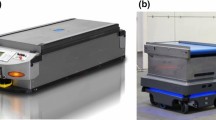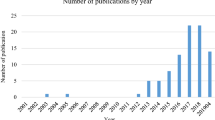Abstract
Assembly job shops form an important part of make-to-order companies. These high-variety production environments are generally characterized by high shop loads and tight delivery dates. Coordinating the completion times of parts to guarantee a timely start of the assembly operations is complex. Most prior studies on coordination in assembly job shops mainly focus on priority dispatching rules, thereby neglecting the coordinating potential of order release decisions. While release and dispatching methods have been extensively studied in the literature, they lack the refined dynamic mechanisms that are needed to effectively coordinate assembly parts. This study refines order pool sequencing rules for order release by utilizing progress, urgency and load-related status information for coordination purposes. A new selection mechanism focusing on the timely release of critical parts is embedded in the release decision. Furthermore, a newly developed dynamic dispatching rule carefully coordinates parts to be assembled, once they are released to the shop floor. Simulation results show that the newly developed methods for dynamic coordination significantly outperform their static versions.




Similar content being viewed by others
References
Adam N, Bertrand JWM, Surkis J (1987) Priority assignment procedures in multi-level assembly job shops. IIE Trans 19(3):317–328
Adam N, Bertrand JWM, Morehead DC, Surkis J (1993) Due date assignment procedures with dynamically updated coefficients for multi-level assembly job shops. Eur J Oper Res 68:212–227
Baker KR (1984) The effects of input control in a simple scheduling model. J Oper Manag 4(2):99–112
Bergamaschi D, Cigolini R, Perona M, Portioli A (1997) Order review and release strategies in a job shop environment: a review and a classification. Int J Prod Econ 35(2):399–420
Bertrand JWM, van de Wakker AM (2002) An investigation of order release and flow time allowance policies for assembly shops. Prod Plan Control 13(7):639–648
Blackstone JH, Phillips DT, Hogg GL (1982) A state-of-the-art survey of dispatching rules for manufacturing job shop operations. Int J Prod Res 20(1):27–45
Doctor SR, Cavalier TM, Egbelu PJ (1993) Scheduling for machining and assembly in a job-shop environment. Int J Prod Res 31(6):1275–1297
Fernandes NO, Thürer M, Silva C, Carmo-Silva S (2017) Improving workload control order release: incorporating a starvation avoidance trigger into continuous release. Int J Prod Econ 194:181–189
Fowler JW, Hogg GL, Mason SJ (2002) Workload control in the semiconductor industry. Prod Plan Control 13(7):568–578
Fredendall LD, Ojha D, Patterson JW (2010) Concerning the theory of workload control. Eur J Oper Res 201:99–111
Fry TD, Oliff MD, Minor ED, Leong GK (1989) The effects of product structure and sequencing rule on assembly shop performance. Int J Prod Res 27(4):671–686
Grundstein S, Freitag M, Scholz-Reiter B (2017) A new method for autonomous control of complex job shops - Integrating order release, sequencing and capacity control to meet due dates. J Manuf Syst 42:11–28
Hendry LC, Kingsman BG, Cheung P (1998) The effect of workload control (WLC) on performance in make-to-order companies. J Oper Manag 16:63–75
Hendry LC, Land MJ, Stevenson M, Gaalman GJC (2008) Investigating implementation issues for workload control (WLC): a comparative case study analysis. Int J Prod Econ 112:452–469
Henrich P, Land MJ, Gaalman GJC (2004) Exploring applicability of the workload control concept. Int J Prod Econ 90:187–198
Holthaus O, Rajendran C (1997) Efficient dispatching rules for scheduling in a job shop. Int J Prod Econ 48:87–105
Holthaus O, Rajendran C (2000) Efficient jobshop dispatching rules: further developments. Prod Plan Control 11(2):171–178
Kanet JJ (1988) Load-limited order release in job shop scheduling systems. J Oper Manag 7(3):44–58
Kanet JJ, Hayya JC (1982) Priority dispatching with operation due-dates in a job shop. J Oper Manag 2(3):155–163
Kingsman BG (2000) Modelling input-output workload control for dynamic capacity planning in production planning systems. Int J Prod Econ 68:73–93
Kundu K, Land MJ, Portioli-Staudacher A, Bokhorst JAC (2021) Order review and release in make-to-order flow shops: analysis and design of new methods. Flex Serv Manuf J 33(3):750–782
Land MJ, Gaalman GJC (1996) Workload control concepts in job shops: a critical assessment. Int J Prod Econ 46–47:535–538
Land MJ, Gaalman GJC (2009) Production planning and control in SMEs: time for change. Prod Plan Control 20(7):548–558
Land MJ, Stevenson M, Thürer M (2014) Integrating load-based order release and priority dispatching. Int J Prod Res 52(4):1059–1073
Lu HL, Huang GQ, Yang HD (2011) Integrating order review/release and dispatching rules for assembly job shop scheduling using a simulation approach. Int J Prod Res 49(3):647–669
Maxwell WL (1969) Priority dispatching and assembly operations via job shop. Report Rm-5370-PR. Rand Corporation, Santa Monica
Mezzogori D, Romagnoli G, Zammori F (2021) Defining accurate delivery dates in make to order job-shops managed by workload control. Flex Serv Manuf J 33(4):956–991
Mohanasundaram KM, Natarajan K, Viswanathkumar G, Radhakrishnan P, Rajendran C (2002) Scheduling rules for dynamic shops that manufacture multi-level jobs. Comput Ind Eng 44:119–131
Oosterman B, Land MJ, Gaalman GJC (2000) The influence of shop characteristics on workload control. Int J Prod Econ 68(1):107–119
Paul M, Sridharan R, RadhaRamanan T (2015) An investigation of order review/release policies and dispatching rules for assembly job shops with multi objective criteria. Procedia Soc Behav Sci 189:376–384
Pereira MT, Santoro MC (2011) An integrative heuristic method for detailed operations scheduling in assembly job shop systems. Int J Prod Res 49(20):6089–6105
Philipoom PR, Markland RE, Fry TD (1989) Sequencing, progress milestones and product structure in a multistage job shop. J Oper Manag 8(3):209–229
Philipoom PR, Russell RS, Fry TD (1991) A preliminary investigation of multi-attribute based sequencing rules for assembly shops. Int J Prod Res 29(4):739–753
Portioli-Staudacher A (2000) ISTS: a new procedure for the integrated scheduling of multi-stage systems. Int J Prod Res 38(11):2489–2514
Portioli-Staudacher A, Tantardini M (2012) A lean-based ORR system for non-repetitive manufacturing. Int J Prod Res 50(12):3257–3273
Ragatz GL, Mabert VA (1988) An evaluation of order release mechanisms in a job shop environment. Decis Sci 19:167–189
Rajendran C, Holthaus O (1999) A comparative study of dispatching rules in dynamic flowshops and jobshops. Eur J Oper Res 116:156–170
Sarin SC, Varadarajan A, Wang LX (2011) A survey of dispatching rules for operational control in wafer fabrication. Prod Plan Control 22(1):4–24
Sculli D (1980) Priority dispatching rules in job shops with assembly operations and random delays. Omega 8(2):227–234
Sculli D (1987) Priority dispatching rules in an assembly shop. Omega 15(1):49–57
Sculli D, Tsang KK (1990) Priority dispatching rules in a fabrication/assembly shop. Math Comput Model 13(3):73–79
Silva C, Roque L, Almeida A (2006) MAPP–A web-based decision support system for the mould industry. Decis Support Syst 42:999–1014
Stevenson M, Hendry LC (2006) Aggregate load-oriented workload control: a review and a re-classification of a key approach. Int J Prod Econ 104(2):676–693
Stevenson M, Hendry LC, Kingsman BG (2005) A review of production planning and control: the applicability of key concepts to the make-to-order industry. Int J Prod Res 43(5):869–898
Stevenson M, Huang Y, Hendry LC, Soepenberg E (2011) The theory and practice of workload control: a research agenda and implementation strategy. Int J Prod Econ 131:689–700
Thiagarajan S, Rajendran C (2005) Scheduling in dynamic assembly job-shops to minimize the sum of weighted earliness, weighted tardiness and weighted flowtime of jobs. Comput Ind Eng 49:463–503
Thürer M, Stevenson M, Silva C (2011) Three decades of workload control research: a systematic review of the literature. Int J Prod Res 49(23):6905–6935
Thürer M, Stevenson M, Silva C, Land MJ, Fredendall LD (2012a) Workload control and order release: a lean solution for make-to-order companies. Prod Oper Manag 21(5):939–953
Thürer M, Stevenson M, Silva C, Huang GH (2012b) The application of workload control in assembly job shops: an assessment by simulation. Int J Prod Res 50(18):5048–5062
Thürer M, Stevenson M, Silva C, Land MJ, Filho MG (2013) Workload control and order release in two-level multi-stage job shops: an assessment by simulation. Int J Prod Res 51(3):869–882
Thürer M, Land MJ, Stevenson M, Fredendall LD, Filho MG (2015) Concerning workload control and order release: the pre-shop pool sequencing decision. Prod Oper Manag 24(7):1179–1192
Thürer M, Stevenson M, Qu T (2016) Job sequencing and selection within workload control order release: an assessment by simulation. Int J Prod Res 54(4):1061–1075
Acknowledgements
This research was supported by the National Natural Science Foundation of China (51975129, 71572049, 61973089) and the Guangdong Provincial Natural Science Foundation of China (2019A1515012158).
Author information
Authors and Affiliations
Corresponding author
Additional information
Publisher's Note
Springer Nature remains neutral with regard to jurisdictional claims in published maps and institutional affiliations.
Rights and permissions
About this article
Cite this article
Liu, J., Land, M.J., Bokhorst, J.A.C. et al. Improving coordination in assembly job shops: redesigning order release and dispatching. Flex Serv Manuf J 35, 669–697 (2023). https://doi.org/10.1007/s10696-022-09454-x
Accepted:
Published:
Issue Date:
DOI: https://doi.org/10.1007/s10696-022-09454-x




